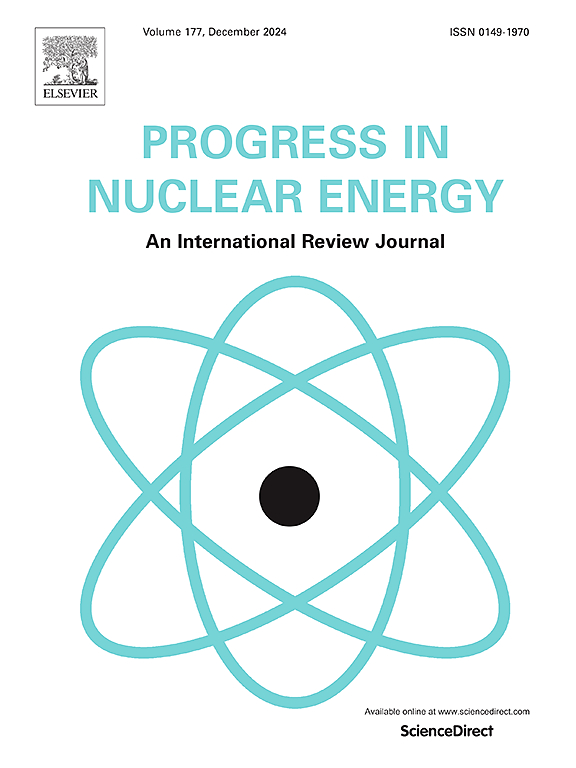Evaluating the performance of passive second-stage hydro accumulators to enhance safety margins at Bushehr NPP
IF 3.3
3区 工程技术
Q1 NUCLEAR SCIENCE & TECHNOLOGY
引用次数: 0
Abstract
Following the Fukushima accident, the nuclear industry acknowledged the significance of passive safety systems that may function autonomously without relying on external power sources or operator involvement. These systems are engineered to deliver reliable and automated safety operations, even in severe circumstances. The Second Stage Hydro accumulator (HA-2) is an autonomous safety system that autonomously introduces coolant into a nuclear reactor during emergencies, without the need for external power. It plays a vital role in the safety architecture of sophisticated VVER reactors. The objective of this study is to examine the influence of the new type of second-stage hydro accumulators (HA-2) compared to the second-stage accumulators (Bushehr) that are only in Bushehr NPP on the occurrence of design extension condition (DEC) during a station blackout and a small break in the coolant pipeline along with an SBO accident. For this purpose, a VVER-1000 thermal hydraulic model for RELAP5 code has been modified to include the HA-2 system. After analyzing the results, it has been concluded that the passive part of the safety system, together with the accumulators (ACCs), performs well enough to prevent core damage in small Loss of Coolant Accident (SB-LOCA) scenarios larger than 70 mm, as well as in Station Blackout (SBO) situations, for a minimum of 13 h. Furthermore, in circumstances including a severe blackout (SBO), the system exhibits adequate performance to prevent any damage to the core for 24 h. These results are based on assessing the system's autonomous capacity, without considering supplementary managerial interventions.
评价被动二级蓄能器的性能以提高布什尔核电站的安全裕度
福岛核事故发生后,核工业认识到被动安全系统的重要性,这种系统可以在不依赖外部电源或操作员参与的情况下自主运行。即使在恶劣的环境下,这些系统也能提供可靠和自动化的安全操作。第二阶段蓄能器(HA-2)是一种自主安全系统,在紧急情况下自动向核反应堆引入冷却剂,无需外部电源。它在复杂的VVER反应堆的安全结构中起着至关重要的作用。本研究的目的是研究新型二级蓄能器(HA-2)与仅在布什尔核电站中使用的二级蓄能器(布什尔)相比,在电站停电和冷却剂管道小断裂以及SBO事故期间,对设计延伸条件(DEC)发生的影响。为此目的,RELAP5代码的VVER-1000热水力模型已被修改以包括HA-2系统。在分析结果后,得出结论,安全系统的被动部分,连同蓄电池(ACCs),在大于70毫米的小冷却剂损失事故(SB-LOCA)情况下,以及在至少13小时的电站停电(SBO)情况下,表现良好,足以防止堆芯损坏。此外,在包括严重停电(SBO)在内的情况下,该系统表现出足够的性能,可以在24小时内防止对核心的任何损坏。这些结果是基于对系统自主能力的评估,而不考虑补充管理干预。
本文章由计算机程序翻译,如有差异,请以英文原文为准。
求助全文
约1分钟内获得全文
求助全文
来源期刊

Progress in Nuclear Energy
工程技术-核科学技术
CiteScore
5.30
自引率
14.80%
发文量
331
审稿时长
3.5 months
期刊介绍:
Progress in Nuclear Energy is an international review journal covering all aspects of nuclear science and engineering. In keeping with the maturity of nuclear power, articles on safety, siting and environmental problems are encouraged, as are those associated with economics and fuel management. However, basic physics and engineering will remain an important aspect of the editorial policy. Articles published are either of a review nature or present new material in more depth. They are aimed at researchers and technically-oriented managers working in the nuclear energy field.
Please note the following:
1) PNE seeks high quality research papers which are medium to long in length. Short research papers should be submitted to the journal Annals in Nuclear Energy.
2) PNE reserves the right to reject papers which are based solely on routine application of computer codes used to produce reactor designs or explain existing reactor phenomena. Such papers, although worthy, are best left as laboratory reports whereas Progress in Nuclear Energy seeks papers of originality, which are archival in nature, in the fields of mathematical and experimental nuclear technology, including fission, fusion (blanket physics, radiation damage), safety, materials aspects, economics, etc.
3) Review papers, which may occasionally be invited, are particularly sought by the journal in these fields.
 求助内容:
求助内容: 应助结果提醒方式:
应助结果提醒方式:


